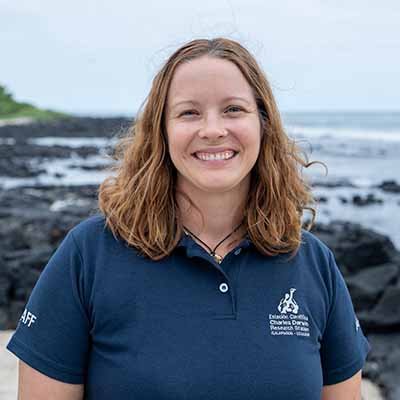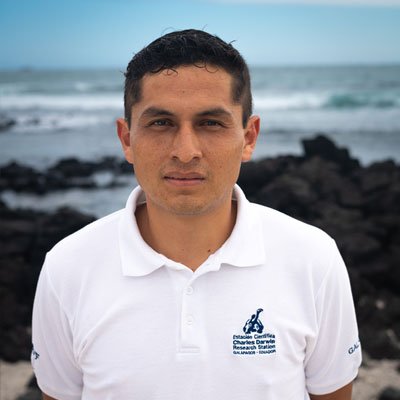Giant tortoises are emblems of Galapagos. They are critical ecosystem engineers, and they are also important for the local economy. Yet, all 12 species of Galapagos Giant Tortoises are of conservation concern. Our work focuses on conserving these gentle giants through research and education.
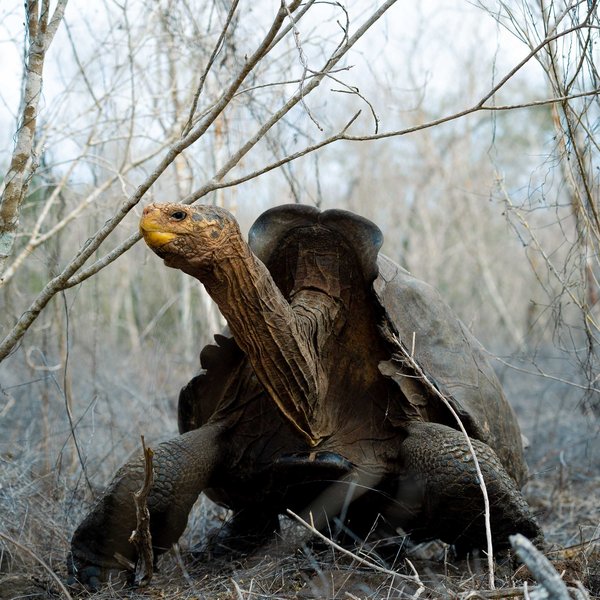
Our team
Courtney Pike
Senior Researcher - Giant tortoise conservation
Freddy Cabrera
Field Researcher
Cristian Peñafiel
Field Assistant
Other collaborators
Stephen Blake (St. Louis University)
Sharon Deem (St. Louis Zoo Institute for Conservation Medicine)
Ainoa Nieto-Claudín (St. Louis Zoo Institute for Conservation Medicine)
Anne Guézou (Galapagos Conservation Trust)
Guillaume Bastille-Rousseau (Southern Illinois University)
Donors
American Association of Zoological Veterinarians
Friends of Galapagos Islands Foundation Netherlands
Galapagos Conservation Trust
Houston Zoo
Johnsonwax del Ecuador S.A.
Metaverse Consulting S.A.S. Ecuador
St. Louis Zoo WildCare Institute
Stefano Ricci Spa
St. Louis Zoo Institute for Conservation Medicine
COmON Foundation
Collaborating institutions
Galapagos Conservation Trust
Galapagos National Park Directorate
Max Planck Institute for Animal Behavior
St. Louis Zoo WildCare Institute
St. Louis University
Washington University in St. Louis
St. Louis Zoo Institute for Conservation Medicine
The challenge
Galapagos tortoises used to roam free on almost all islands in the Galapagos. Yet, two centuries of overhunting led to the extinction of several species and reduced others to critically small population sizes. Today, giant tortoises are threatened further by climate change, invasive species, habitat fragmentation, and the introduction of new diseases.
GALAPAGOS TORTOISE MOVEMENT ECOLOGY PROGRAM
The Galapagos Tortoise Movement Ecology Program (GTMEP) works to conserve the imperiled giant tortoises of the Galapagos Islands by studying many aspects of their biology, health, threats, and conservation solutions, as well as by contributing to community education.
The program is a multi-institutional collaboration between the Charles Darwin Foundation, the Galapagos National Park Directorate, and the Saint Louis Zoo Institute for Conservation Medicine.
What we do
Our program works with four species of Galapagos tortoises on three islands一 Isabela, Santa Cruz, and Española一and covers the full ecological range of these species. The program has six research components:
Movement ecology
This research aims to understand the evolutionary ecology of movement strategies, including the role of tortoise migration on ecosystem processes, habitat use, and interactions with threats.
Reproductive ecology
This research aims to understand the reproductive biology of tortoises, especially in relation to climate change.
ECOSYSTEM ROLES AND PROCESSES
This research aims to understand the role of giant tortoises in Galapagos ecosystems, including their structuring of freshwater ponds and plant communities.
Health
This research aims to document endemic diseases of tortoises and monitor for introduced diseases that may be transmitted between domestic animals, humans, and wildlife. This information can be used to inform preventive conservation management and control actions.
Socio-ecosystem
This research aims to understand the costs and benefits of tortoise-human interactions. Galapagos tortoises and local people can only thrive if they achieve a win-win relationship.
Education and outreach
This component aims to translate the program's research results into meaningful information for local stakeholders, particularly youth, and inspire the next generation of conservation leaders.
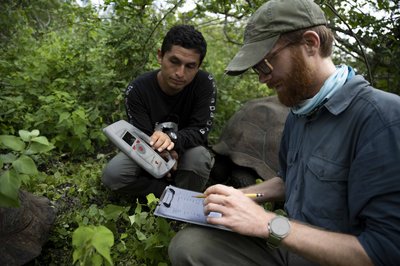
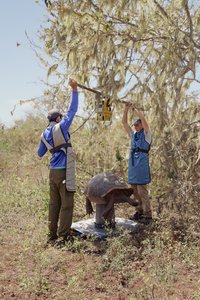
Specific program objectives
- Continue monitoring tortoise migratory activity and analyze 12 years of movement data to predict how tortoises will be affected by environmental change.
- Study the early life (“lost years”) of giant tortoises through investigation of the nest environment as well as the growth, survival, and habitat use of juveniles.
- Collaborate with the Galapagos National Park Directorate to analyze 10 years of data on egg hatching success across nesting zones to investigate how the environment affects offspring.
- Determine how the number of eggs laid by a female tortoise (fecundity) relates to her movement patterns, to understand the relationship between migration and health.
- Study the long-term impact of the Cuban Cedar (Cedrela odorata) on tortoise movement and migration, and develop strategies to reduce the impact of this invasive tree.
- Continue to engage local communities through education and training opportunities.
Why it matters
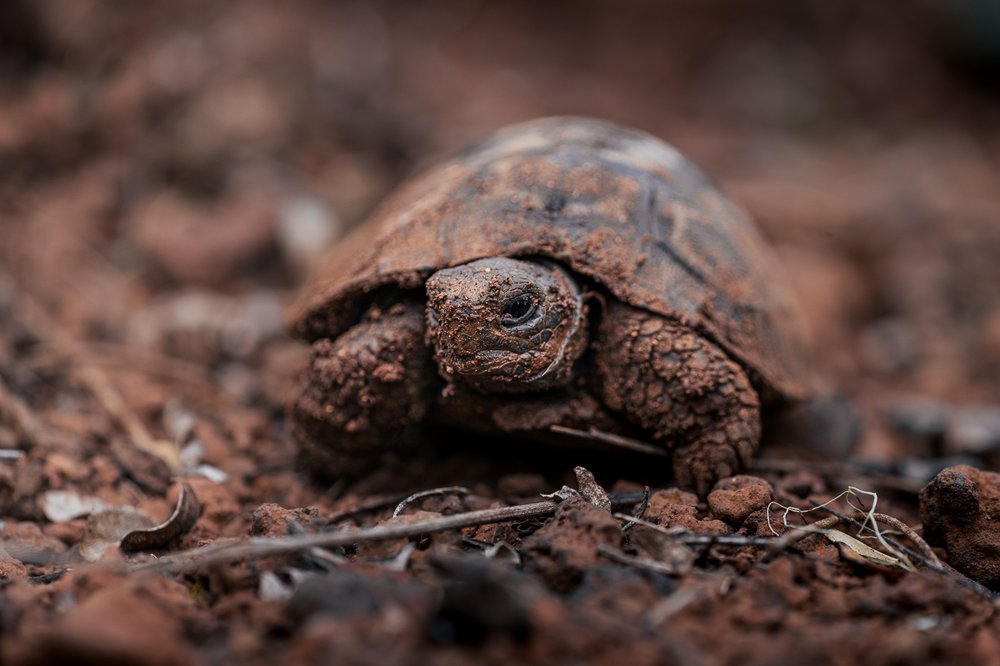
Understanding the migration patterns of tortoises is essential to inform management plans and conservation efforts aimed at protecting these iconic species, both inside the National Park and in rural areas, where humans and tortoises share the land.
As long-lived animals, giant tortoises act as “sentinel” species, providing information about the health of their ecosystems. Environmental contaminants and emerging infectious diseases are of pressing concern for human and wildlife health. Indeed, tortoises may harbor disease-causing agents that not only affect their health, but may also be shared with domestic animals and humans.
Our impact
The information generated by our scientists has helped define specific management plans and strategies to protect giant tortoises. Some of the most important actions that have been implemented based on our research outputs include:
- Establishment of regulations for the use of private areas as tortoise tourist attractions to protect the wellbeing of tortoises and minimize disturbance to wildlife.
- Management efforts to reduce threats to vulnerable tortoise nesting areas and delimitation of new nesting areas.
- Active coordination to control invasive species including wild goats, pigs, ants, blackberry, and guava, among others, to help protect tortoises from competition and predation.
- Implementation of tortoise health checks before relocation of individuals to other islands to help prevent the spread of diseases.
In 2018, our researchers, in partnership with the St. Louis Zoo Institute for Conservation Medicine, implemented the first mobile molecular diagnostic laboratory to support the analysis of infectious diseases in wildlife. They also provided capacity building for local veterinarians in reptile medicine, surgery, and diagnostics. In 2022, X-rays of giant tortoises were conducted in the wild – a world first – to track their reproductive health.
Our work has contributed to the implementation of best health practices and protocols with both captive and free-living tortoises, to improve disease diagnostics, and to design and implement an infectious disease surveillance plan for tortoises, which serves as a template for active disease surveillance of other Galapagos wildlife.
To date, the giant tortoise education program, a partnership between the Galapagos Conservation Trust and Charles Darwin Foundation, has engaged approximately 25% of the Galapagos youth in field-based educational experiences – teaching them about tortoise conservation and inspiring them to join conservation efforts.
WHY YOU SHOULD SUPPORT US
By supporting our giant tortoise program, you are helping us develop long-term conservation solutions that will benefit both humans and wildlife by maintaining the ecological integrity of giant tortoise migrations. Importantly, you are helping to ensure a future for these amazing creatures and the ecosystems that depend on them!
Here are some specific examples of how your donation could be used:
- It could help us to track the movements of giant tortoises, so that we can better understand their habitat needs.
- It could help us to develop new technologies to monitor their health in the wild.
- It could help us to scale up our education efforts in the local communities about the importance of giant tortoises.
Where it all started and how to get involved
The Galapagos Tortoise Movement Ecology Program began with two researchers, a pair of bicycles, and support from the Max Planck Institute for Ornithology, the Charles Darwin Foundation, and the Galapagos National Park Directorate. Over the years, the Program evolved to include a principal investigators, two local field staff, an outreach and education
coordinator, and many local, national, and international students, and collaborators that have summed to over 60 people in 15 years of outreach and education. And we’re just getting started! Check the vacancies page of the Charles Darwin Foundation to see if there are opportunities to become involved with giant tortoise education and research.
Resources
Introductory readings
“With an Internet of Animals, Scientists Aim to Track and Save Wildlife.” 2020. New York Times.
“Tales of a tortoise tracker.” 2013. Galapago Matters.
Blake S, Deem SL, Nieto Claudin A, Cabrera F. 2021. The Galapagos Tortoise Movement Ecology Programme: What have we learned about tortoise movement and what does it mean for conservation? Testudo 9(3): 1–19.
Sampling of peer-reviewed research papers
Bastille‐Rousseau G, Gibbs JP, Yackulic CB, Frair JL, Cabrera F, Rousseau L‐P, Wikelski M, Kümmeth F, Blake S. 2017. Animal movement in the absence of predation: Environmental drivers of movement strategies in a partial migration system. Oikos 126(7): 1004–1019.
Bastille‐Rousseau G, Yackulic CB, Gibbs JP, Frair JL, Cabrera F, Blake S. 2019. Migration triggers in a large herbivore: Galapagos giant tortoises navigating resource gradients on volcanoes. Ecology 100(6): e02658.
Benitez-Capistros F, Couenberg G, Nieto A, Cabrera F, Blake S. 2019. Identifying shared strategies and solutions to the human–giant tortoise interactions in Santa Cruz, Galapagos: A nominal group technique application. Sustainability 11(10): 2937.
Blake S, Wikelski M, Cabrera F, Guézou A, Silva M, Sadeghayobi E, Yackulic CB, Jaramillo P. 2012. Seed dispersal by Galápagos tortoises. Journal of Biogeography 39(11): 1961–1972.
Deem SL, Rivera S, Nieto-Claudin A, Emmel E, Cabrera F, Blake S. 2023. Temperature along an elevation gradient determines Galapagos tortoise sex ratios. Ecology and Evolution 13(4): e10008.
Nieto-Claudin A, Deem SL, Rodríguez C, Cano S, Moity N, Cabrera F, Esperón F. 2021. Antimicrobial resistance in Galapagos tortoises indicate a growing human footprint. Environmental Pollution 284: 117453.
Nieto-Claudin A, Esperón F, Apakupakul K, Peña I, Deem SL. 2021. Health assessments uncover novel viral sequences in five species of Galapagos tortoises. Transboundary and Emerging Diseases 69(4): e1079–e.1089.
Pike KN, Blake S, Cabrera F, Gordon IJ, Schwarzkopf L. 2022. Body size, sex and high philopatry influence the use of agricultural land by Galapagos giant tortoises. Oryx 56(1): 17–25.
Pike KN, Blake S, Gordon IJ, Cabrera F, Rivas-Torres G, Laso FJ, Schwarzkopf L. 2023. Navigating agricultural landscapes: Responses of critically endangered giant tortoises to farmland vegetation and infrastructure. Landscape Ecology 38: 501–516.
Yackulic CB, Blake S, Bastille‐Rousseau G. 2017. Benefits of the destinations, not costs of the journeys, shape partial migration patterns. Journal of Animal Ecology 86(4): 972–982.

Protect Galapagos, Impact the World
The impact you make on this small ecosystem of enormous biodiversity is part of a larger footprint you are leaving for the world's future. Join us on our mission to safeguard one of our planet’s most important natural treasures through science and conservation action by making a donation today. Thank you for making an impact with us.




